Time to dish the dirt on Philodendron atabapoense, a stunning and often overlooked tropical plant with long, deep green strap-shaped leaves.
(Did we mention its dazzling maroon backs?)
We know you’re eager to unravel the secrets of this lovely plant, and we’re here to help. In this comprehensive Philodendron atabapoense care guide, we’ll cover everything from lighting and watering to propagation and troubleshooting common issues.
(And as always, if you want to skip to a specific section, just check out the table of contents below and hop right to the area you need.)
Table of Contents
Philodendron Atabapoense care
History, Habitat, and Characteristics

Philodendron atabapoense, a climbing tropical plant from the green forests of Venezuela, has long, slender leaves that appear simple and dark green at first glance. They’re relatively thin, growing up to 30 inches long but only three feet wide, almost like stretched out deep green hearts.
Once you take a closer peek, you’ll discover a striking burgundy underside that slowly changes into an eye-catching purple-magenta shade as a mature Philodendron atabapoense plant develops.
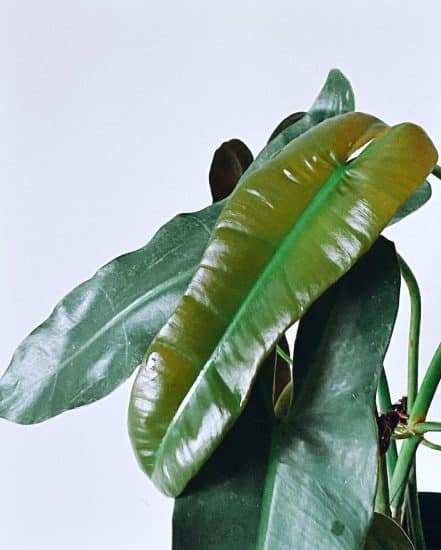
What’s even cooler? In its mature form, Philodendron atabapoense resembles the Philodendron spiritus-sancti (one of the rarest and most expensive plants in the world!). But don’t worry, unlike the latter rare plant, this Venezuelan beauty won’t empty your wallet.
In its natural habitat, our adventurous Philodendron atabapoense is a climbing plant that explores, always looking for a pole or support. Want to make it feel right at home? Give it a moss pole (it’ll thank you later) to reach new heights, even indoors!
Speaking of the great indoors, let’s get into the ideal inside environmental conditions for Atabapoense plants.
Light

The Philodendron atabapoense plant is quite adaptable and can tolerate a range of lighting conditions, from medium indirect light to even a bit of direct light!
You see, when given medium light, your Atabapoense Philodendron tends to stretch its internodes and petioles towards the light (who wouldn’t want to grow towards that warm, bright goodness?). But it can handle direct sunlight for one to two hours a day without getting burnt.
The perfect spot for your plant is near a northwest-facing window where it can bask in all that lovely sunlight. If you have it in a spot where it’ll receive more direct light than it can handle, just move it back a few feet or filter the light with a sheer curtain.
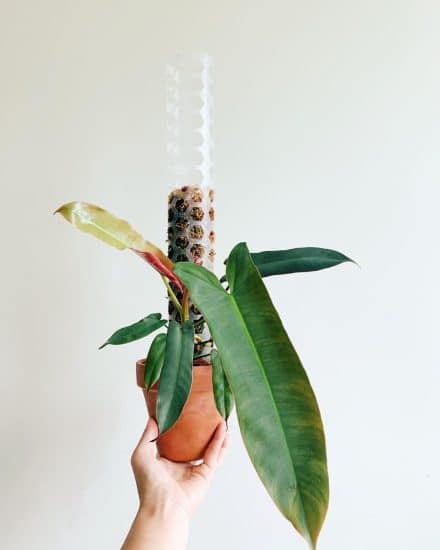
Now, how can you tell if your Philodendron Atabapoense is getting the right amount of light? Here are some signs to look out for:
Not enough light: Is your plant looking a bit leggy and stretched, as if it’s reaching for something? Yup, you guessed it, it’s craving more light! Try moving it closer to the window or to a brighter spot in your home.
Too much light: While your plant is a bit of a sun-lover, if you notice its leaves getting faded or scorched (or even developing brown spots), it’s time to pull it away from those strong rays. A sheer curtain can work wonders in filtering out that excess sunlight and keeping your Philodendron atabapoense’s leaves looking lush and vibrant.
Water
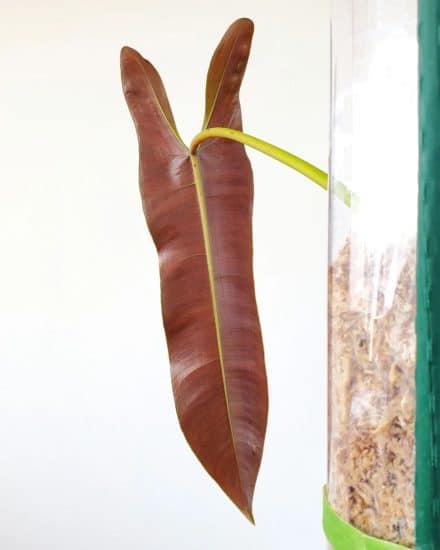
Your Philodendron atabapoense plant doesn’t have picky water requirements. Just like its philodendron cousins, it loves drying out between waterings.
Don’t water on a set schedule — instead, let the soil tell you what it needs when. This will depend on factors like temperature, pot size, soil composition, to name a few. For instance, if you’re in a hot area and your plant is in a terracotta pot with a chunky potting mix, you might even need to water it daily.
As you might expect, you really shouldn’t let your Philodendron atabapoense stand in water, since it’s not a fan of soggy roots.
The main takeaway: when the soil is dry a few inches down to the touch, time to water!
Our Philodendron atabapoense watering tips:
- Too little water? The oldest leaves (the ones at the bottom) will start turning brown, curling up, and getting all crispy. Water your plant a bit more often, making sure you wet the soil thoroughly.
- Overwatering? You’ll see yellowing leaves, mushy stems, and soil that just won’t dry up. (Not the best look, right?) To fix this, cut back on your watering schedule and give the soil some time to dry out.
- Remember to let that excess water flow out out of your pot’s drainage holes, and avoid letting your plant take a bath in standing water.
Temperature and Humidity

While your Atabapoense philodendron can tolerate temperatures between 55°F to 80°F, it will thrive in higher temps. Be cautious of sudden drops in temperature, since this can cause damage to the plant’s leaves and roots. If you have a drafty window or doorway nearby, consider relocating your plant to a more stable environment.
Philodendron atabapoense can do just fine in the wide humidity range of 30% all the way up to 90% during rainy periods. However, for optimal growth, it’s best to aim for a humidity level somewhere in the middle.
Just remember that while higher humidity levels can contribute to the plant’s overall health and speed of growth, they’re not absolutely necessary for its survival.
If your plant’s leaves are excessively damp or show signs of rot, it might mean humidity levels are too high. On the other hand, if you notice that its leaves are turning yellow or developing brown edges, this could indicate that the humidity level is too low.
Soil and Planting
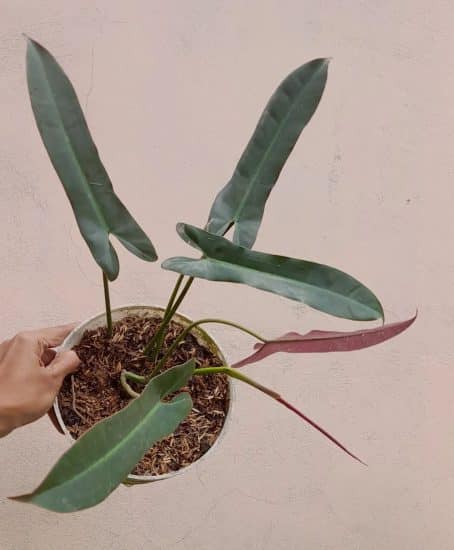
The Philodendron atabapoense thrives in an airy, chunky soil that allows it to grip while ensuring quick drying. An ideal mix for this plant is an aroid potting soil with ingredients that promote aeration and drainage, like orchid bark, perlite, and coco coir.
Our recommended Philodendron atabapoense soil mix:
- 40% orchid bark
- 30% potting soil
- 20% peat moss or coco coir
- 10% perlite
If you you haven’t gotten the mix quite right, you’ll see signs like yellow leaves, wilting, or stunted growth. An ideal potting soil should have good aeration and drainage to prevent root rot, so if you see these signs and have ruled out other issues, switch it up!
Fertilizer
Fertilize your Atabapoense Philodendron with a combination of slow-release fertilizer, worm castings, and diluted synthetic fertilizer.
Keep in mind that using too much fertilizer can cause issues like yellow leaves, brown leaf tips or edges, and dropping leaves. If you suspect overfertilization, immediately stop fertilizing and water the plant thoroughly to flush out excess fertilizer.
If you notice improvement, gradually reintroduce a balanced and diluted fertilizer in combination with worm castings and slow-release fertilizer.
Repotting

As your philodendron plant grows, it will eventually require repotting into a larger container. Philodendron atabapoense generally need to be repotted once every 2-3 years. You should replace the soil every year at the start of the growing season so it gets fresh nutrients, though, whether you repot it or not.
When repotting, carefully handle the root ball to avoid damaging the plant. Choose a new pot only slightly larger than the current container, with drainage holes to prevent root rot.
Remember to be patient and give your Philodendron atabapoense enough time to acclimate to its new environment before attaching it to a pole for support. This will ensure a healthy transition and encourage optimal growth for your plant.
Propagation Guide
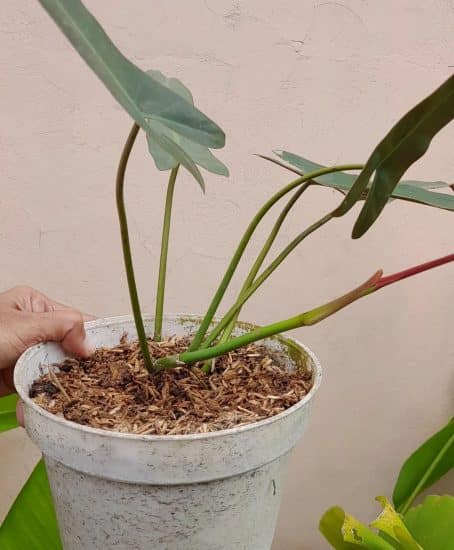
Propagating Philodendron atabapoense is a breeze using stem cuttings, and we’re going to walk you through the process step by step.
Propagating Philodendron atabapoense by stem cuttings:
- It’s all about the cut: Snip your plant at various spots (or just one), making sure there’s at least one aerial root on your stem cutting. Oh, and keep at least one leaf on the cutting too — that little guy needs the energy for new roots to grow. For best results, choose a healthy stem with at least two nodes.
- Choose your own adventure: Next up, pick your propagation method. Water, sphagnum or peat moss, or aroid potting mix — your call! Each one has its perks, so pick the one you feel most comfortable with. I tend to prefer water so I can see the roots grow and avoid a transition between mediums, but it’s your adventure.
- Set the stage for growth: Now, let’s get that cutting ready to grow. If you’re going with water, plop your cutting in a container filled with filtered water, making sure only the nodes are underwater and not the leaves. For the peat or sphagnum moss route, you’ll want damp moss but not so wet that it’s a soggy mess. Snugly wrap it around the aerial roots. And if you’ve chosen aroid potting mix, plant your cutting with some breathing room for that new growth point to flourish in the moist soil.
- Keep ’em cozy: Find a sunny spot with bright, indirect light for your cutting to call home. And hey, humidity is your friend here — so consider putting a clear plastic bag or a soda bottle cut in half over the top of your cutting to keep those levels up Lift up the covering at least once a day for a few minutes to encourage air circulation, and if the cutting is in moss or soil, keep it consistently moist.
- Sit back and watch the magic happen: It’s a waiting game now, but soon enough, you’ll spot new growth points and fresh roots.
Our propagation tips:
- Snip-snap! Sterilized shears or scissors are a must when taking cuttings. You want to keep those pests and diseases far away from your green babies.
- Timing is everything. Propagating during the growing season is your best bet for speedy root development and overall growth. Early spring and early summer are ideal times for outdoor planting or repotting.
- Don’t forget about airflow. Whether you’re going the water, peat moss, or potting mix route, let your cutting breathe a little to prevent mold, rot, or fungal diseases. Keeping the plant’s roots healthy will result in better root growth and overall plant health.
Common Issues

Let’s get into some of the problems your Philodendron atabapoense may run into and how we can tackle them together. They’re the same problems all philodendron species face, so they have time-tested solutions (phew!).
Yellowing Leaves

One issue that tends to pop up with all philodendron plants, including your Atabapoense, is yellow leaves. This usually happens when you’re watering too much or if the potting soil isn’t draining well enough.
Let’s get that sorted out, shall we? First, try being more mindful of your watering routine, allowing the soil to dry out thorougly between waterings during spring and summer. You could also jazz up your potting mix with some perlite to help with drainage and aeration.
If those pesky yellow leaves just won’t go away, consider repotting your plant into fresh, well-draining soil and a pot with proper drainage holes.
Slow Growth
Another common issue that might slow down your Philodendron atabapoense, especially during spring and summer, could be insufficient light or a potting soil that’s holding too much water. This limits the oxygen available for the roots, which isn’t great for your plant’s health and growth.
If your plant seems like it’s not growing or putting out new leaves, this could be the cause.
So, how do we get your plant growing at a healthy pace? Try relocating your Philodendron atabapoense to a spot with more indirect sunlight – they absolutely love it! Sprucing up the potting mix can work wonders as well. Adding materials like perlite, orchid bark, or even some gravel will help with aeration and drainage, ensuring your plant has the ideal environment to thrive.
Pests and Diseases

All philodendron plants, including your Atabapoense, can occasionally face obstacles like pests and root rot. Let’s get into how we can identify, treat, and prevent these problems.
Pests
The Philodendron Atabapoense is quite clever — it produces extrafloral nectaries (“extrafloral” means they aren’t used in pollination, and nectaries are glands that produce . . . nectar!).
The extrafloral nectaries attract ants, and these ants in turn protect the plant from other pests. Pretty cool, right? However, sometimes unwanted guests like spider mites, mealybugs, and aphids may still show up.
To spot these tiny troublemakers, look for small white bugs or webbing under the leaves and around the stems. Found some? All right, first things first, isolate your plant to protect its neighbors.
Next, grab a damp cloth and gently wipe the affected areas. If those little invaders just won’t give up, it’s time to bring out the insecticide (make sure to follow the directions on the label), or neem oil.
(We prefer neem oil.)
To keep your plant pest-free, keep a watchful eye on it and maintain the right growing conditions. And if ants become too much of a nuisance, you can always use ant bait or rinse them off, which keeps spider mites away, too.
Root Rot
This issue can sneak up on any indoor plant, including your Philodendron atabapoense. It usually happens when the plant gets a bit too much water or the soil stays soggy for too long.
So, how do you know if root rot is creeping in? Be on the lookout for wilting leaves, yellowing foliage, and dark, slimy roots. If these symptoms sound familiar, it’s time to rescue your plant.
Take your plant out of its pot, snip away the affected roots (don’t forget to sterilize your cutting tool before and after), and give it a fresh start in well-draining soil. You can add perlite, pumice, or LECA to improve aeration and drainage.
The key to preventing root rot is all about balance. Only water when the top two inches of soil feel dry, and ensure your pot has at least one drainage hole.
Conclusion
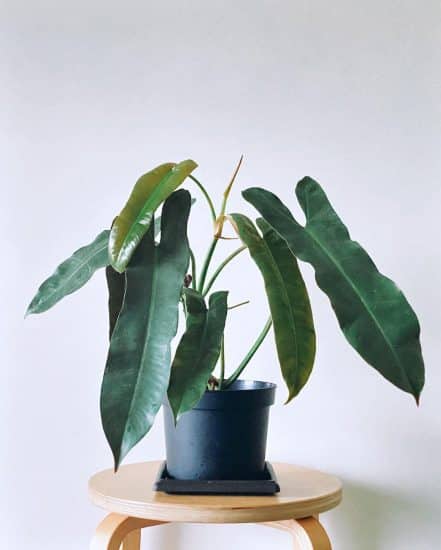
You’ve made it all the way to the end of our Philodendron atabapoense care guide! You now have all the knowledge and tips needed to keep your stunning Venezuelan climber thriving.
Give some Philodendron atabapoense cuttings to your friends and watch their eyes light up when they clock those burgundy undersides.
We hope this care guide helps you to nurture and enjoy your Philodendron atabapoense for many years to come. Feel free to reach out on socia media with any questions or concerns — we’re here to help! And don’t hesitate to share this guide with fellow plant lovers who might appreciate the tips.
Take care, and happy planting!
FAQ
Is Philodendron Atabapoense rare?
A resounding yes. While not as rare as the Philodendron spiritus sancti (considered the “holy grail” of rare plants), the Atabapoense is still a stunning addition to any indoor plant collection, and unlike the Spiritus sancti, it won’t break the bank!
Is Philodendron Atabapoense fast-growing?
You bet! The Philodendron atabapoense is known for its speedy growth, especially when given the right care and environment. Just remember to provide a moss pole for support, and you’ll see your plant buddy reach for the stars!
What is the difference between Philodendron atabapoense and Philodendron billietiae?
Great question! While both plants belong to the Philodendron genus, they do have some distinct differences. The Philodendron atabapoense is known for its long, slender leaves with a dark green top side and a striking burgundy underside that changes to a purple-magenta shade as the plant matures.
On the other hand, Philodendron billietiae has long, narrow, wavy-edged leaves that appear lighter green and feature striking orange leaf petioles. So, while they might look somewhat similar at first glance, the leaf shape, color, and other unique features set them apart.
Does Philodendron atabapoense climb?
Yes! In its natural habitat, the adventurous Philodendron atabapoense is a climbing plant, always on the lookout for poles or other supports to latch onto. To make it feel right at home indoors, provide a moss pole or any other support structure, and watch your Atabapoense reach new heights. Not only will this support structure help maintain its climbing habit, but it will also encourage the plant to grow strong and healthy.
Is Philodendron atabapoense toxic?
Like other philodendron plants, this one is toxic due to the calcium oxalate crystals it produces, so keep it away from curious kids and pets.


